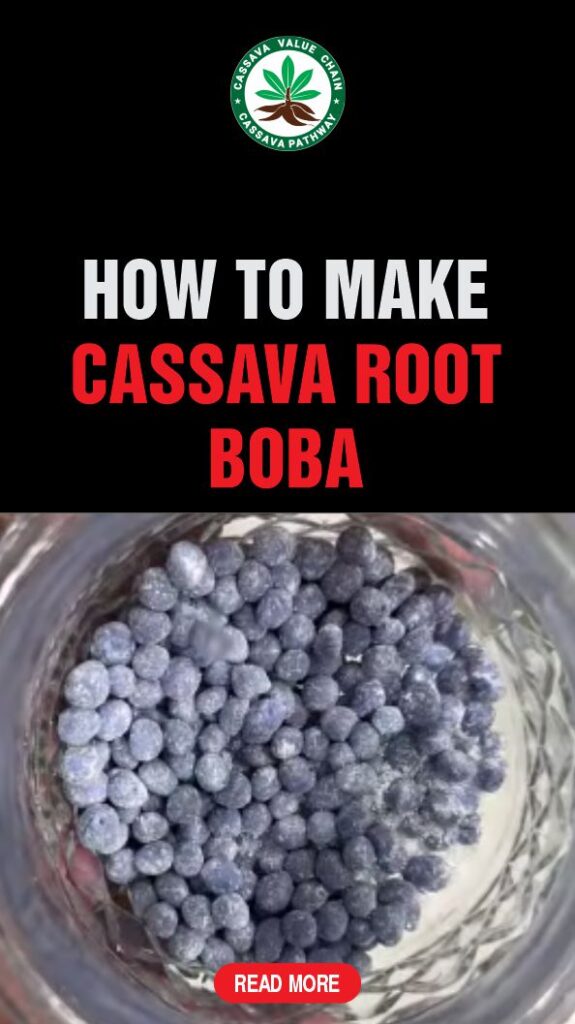Learn how to make cassava root boba using cassava tuber! This unique twist on traditional tapioca pearls offers a different texture and flavor, perfect for enhancing your bubble tea experience.
Bubble tea lovers are familiar with the classic chewy tapioca pearls that make this drink so enjoyable.
However, did you know that you can make boba pearls directly from cassava root – the cassava root boba?
Unlike traditional pearls made from refined tapioca starch, using whole cassava root creates a boba with a slightly different texture and a richer, earthier taste.
This method not only adds a unique twist to your favorite drink but also brings out the natural qualities of cassava.
Whether you’re a bubble tea enthusiast or simply curious about new ways to enjoy cassava, making boba from cassava plant root opens up exciting possibilities.
Let’s explore how you can create these homemade pearls and elevate your bubble tea experience!
Related: Native Cassava Starch from Cassava Tuber and How it is Made

Table of Contents
- What is Cassava Root Boba?
- The Difference Between Cassava Root Boba and Tapioca Pearls
- Nutritional Benefits of Cassava Root Boba
- How to Make Cassava Root Boba at Home
- How to Use Cassava Root Boba
- Tips for Perfect Cassava Root Boba
- Conclusion
What is Cassava Root Boba?
Cassava root boba refers to boba pearls made using cassava root instead of just its extracted starch.
While tapioca pearls come from refined tapioca starch, boba from cassava root uses a more natural form of the plant, often incorporating grated or mashed cassava into the dough.
This results in a slightly different texture and a richer taste compared to conventional tapioca pearls.
Related: How Safe is it to Eat Raw Cassava Root?
The Difference Between Cassava Root Boba and Tapioca Pearls
The primary distinction between cassava root boba and traditional tapioca pearls lies in their ingredients and processing:
- Tapioca Pearls: These are made purely from tapioca starch, which is extracted from cassava root and processed into dough. The dough is then rolled into small spheres, boiled, and sweetened.
- Cassava Root Boba: Instead of using just tapioca starch, boba from cassava root incorporates fresh or boiled cassava root, which may be mashed or grated. This gives the pearls a denser texture and a slightly earthy flavor.
Related: How to Make Cassava Root Safe to Eat
Nutritional Benefits of Cassava Root Boba
Boba from cassava root contains slightly more fiber and nutrients than regular tapioca pearls since it retains more of the whole cassava root. Some benefits include:
- Rich in Carbohydrates: Cassava is a great source of energy due to its high starch content.
- Contains Dietary Fiber: Unlike refined tapioca starch, whole cassava root retains some fiber, aiding digestion.
- Gluten-Free: Like traditional tapioca pearls, boba from cassava root is naturally gluten-free, making it a good option for those with gluten intolerance.
- Source of Minerals: Cassava contains small amounts of calcium, potassium, and iron, contributing to overall health.
Related: Recipes of Boiled Cassava Tuber
How to Make Cassava Root Boba at Home
If you want to try making cassava root boba from scratch, follow this step-by-step guide:
Ingredients:
- 1 medium cassava root (about 500g)
- 1 cup tapioca starch (or more, if needed)
- 2 tablespoons brown sugar (optional, for added sweetness)
- Water for boiling
- Ice water for cooling
Instructions:
1. Prepare the Cassava Root
Peel the cassava root and rinse it thoroughly. Cut it into chunks and boil it in water until soft (about 20-30 minutes). Once tender, drain and mash the cassava until smooth.
2. Mix with Tapioca Starch
Gradually add the tapioca starch to the mashed cassava while kneading until a smooth dough forms. If the dough is too sticky, add more starch until it is easy to handle.
3. Shape the Boba Pearls
Take small portions of the dough and roll them into tiny balls, about the size of a marble. Ensure they are uniform in size to cook evenly.
4. Boil the Boba Pearls
Bring a pot of water to a rolling boil. Add the pearls and cook for 15-20 minutes until they float and become chewy.
5. Cool and Sweeten
Drain and transfer the cooked pearls to an ice-water bath for a few minutes to firm up their texture. For added flavor, soak them in brown sugar syrup or honey.
6. Serve
Your homemade cassava root boba is now ready to be added to your favorite bubble tea or dessert.
Recommended: Different Ways of Cooking Cassava Root
How to Use Cassava Root Boba
Cassava root boba can be used in various drinks and desserts, including:
- Classic Milk Tea: Add the boba to your preferred milk tea flavor, such as black tea, matcha, or taro.
- Iced Coffee: Mix cassava boba with sweetened iced coffee for a refreshing drink.
- Fruit-Based Bubble Tea: Pair with fruity flavors like mango, lychee, or passion fruit tea.
- Desserts: Use in puddings, ice cream, or sweet coconut milk soups for an extra chewy texture.
Related: 34 Benefits of the Cassava Tuber
Tips for Perfect Cassava Root Boba
- Use Fresh Cassava: Freshly boiled cassava root provides better consistency compared to pre-packaged or frozen alternatives.
- Balance the Tapioca Starch: Too much starch can make the pearls too hard, while too little can make them overly sticky.
- Sweeten for Better Taste: Soaking the cooked boba in brown sugar syrup enhances its flavor.
- Serve Immediately: Cassava root boba is best enjoyed fresh, as it may harden over time.
Conclusion
Cassava root boba offers a creative and delicious alternative to traditional tapioca pearls.
By using the whole cassava root, you get a richer texture and a more natural flavor.
Whether you add it to milk tea, coffee, or desserts, this unique twist on boba is sure to impress.
Try making it at home for a fresh, homemade touch to your favorite drinks!

Chimeremeze Emeh is a writer and researcher passionate about Africa’s most transformative root crop—cassava. Through his work at cassavavaluechain.com, he explores the entire cassava industry, from cultivation and processing to its diverse applications in food, health, and industrial use.
He also writes for palmoilpalm.com, where he shares his extensive experience and deep-rooted knowledge of palm oil, covering red palm oil, palm kernel oil, and refined products. His work there reflects his lifelong connection to agriculture and his commitment to promoting sustainable value chains in Africa.
Driven by curiosity and purpose, Chimeremeze aims to shed light on how cassava continues to empower communities, strengthen food systems, and link traditional farming wisdom with modern innovation.

